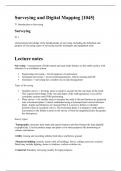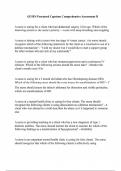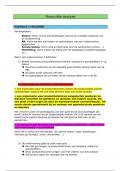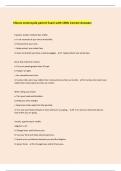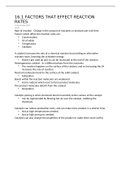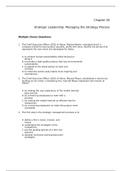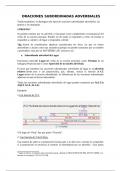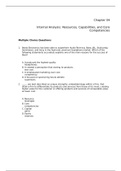T1 Introduction to Surveying
Surveying
T1.1
-Demonstrate knowledge of the fundamentals of surveying; including the definition and
purpose of surveying, types of surveying and the techniques and equipment used.
Lecture notes
Surveying→ measurement of both natural and man made features on the earths surface with
reference to a coordinate system.
Engineering surveying→ for the purpose of construction
Geospatial surveying→ involves photogrammetry, remote sensing and GIS
Geomatics→ surveying has a modern use in data management
Types of Surveying
Geodetic survey→ for large areas so needs to account for the curvature of the earth.
This requires knowledge of the size and shape of the earth [geodesy]. Uses global
coordinate systems and GNSS positioning.
Plane survey→ for smaller areas so assumes the earth is flat and features are projected
onto a horizontal plane. Control established using a horizontal and vertical reference
plane. Angles and distances are measured but it is easier to define or calculate
positions than in a geodetic survey. The horizontal plane is a tangent to earth surface
[curvature] so the further a point on the survey is from the tangential point, the greater
the discrepancy.
Survey types:
-Topographic; measures man made and natural features and then formats the data digitally
or graphically. Used to produce maps and plans or for other purposes like monitoring or
volume calculations.
-Utility; tracing and recording utilities both above and below ground.
-Measured building; outside/ inside walls of buildings, floors, ceilings and cross sections.
Detail may include lighting, doors or windows, sockets switches etc.
-Cadastral; boundary surveying usually for legal purposes.
,-Engineering; locating the best positions for a construction and to make sure a structure is
built to scale in the correct place.
-Geological; locating and recording geological features to produce geological maps.
-Hydrographic; measure/ portray the surfaces covered by water. Involves measurement of
waters dynamics. For mapping of coastlines, navigational charts, offshore resource
explorations, marine based energy projects, scientific study or construction and maintenance
of water based infrastructures.
-Photogrammetry; use of photography to measure distances, widely used in architecture,
engineering, forensics etc.
-Remote sensing; collects information from images using the electromagnetic spectrum.
-GIS; computer based systems that geospatial data and other forms of data to be integrated,
used in geoscience.
Surveying is used in exploration geology to discover mineral deposits using remote sensing.
In mine surveying, surveys are crucial for the correct positioning and orientation of mining
infrastructure. Also in site control of mines and mine closures.
Coordinate systems
T1.2
-Demonstrate a basic understanding of coordinate systems and how to adapt to different
scales and coordinate systems around the world.
Lecture notes
Coordinates allow us to quantify our position on the earths surface within a terrestrial
referencing system.
Distances and coordinates; measured to 3.d.p. Angles and bearings; measured using the
sexagesimal system [degrees, minutes, seconds].
Cartesian coordinate system; where the axis x and y are perpendicular to one another and
intersect at the origin of the system. In surveying the x axis is the east axis and the y axis is
the north axis. The origin is SW. Eastings and northings are given in the format (x,y). If three
dimensional, the z value is also given.
Polar coordinates; quantify a position by its horizontal distance from the origin and the
north axis, given as a bearing followed by a horizontal distance.
, The global coordinate system requires an appreciation of geodesy. The 'geoid model' where
vertical is always parallel to gravity. gravity direction is variable so earths surface is irregular,
making it difficult to use in coordinate system. The 'ellipsoid model' is theoretical and a 'line
or best fit' around the true shape. This is used as earths radius is greater around the equator.
We use WGS 84.
The UKs national coordinate system is OSGB36. This is a plane coordinate system and is ore
manageable than a WGS.
Arbitrary coordinate systems may be used in the creation of a local, small scale survey that
does not need to be connected to the national grid.
Surveying equipment, methods and mathematics
T1.3
-Solve engineering problems using basic trigonometrical techniques.
Lecture notes
Measurements taken in surveying:
-Horizontal anglees
-Vertical angles
-Slope distances
-Horizontal distances
-Elevation
-Coordinates
-Automatic levels and digital levels can be used to measure elevation.
-Magnetic compasses, optical theodolites and electronic theodolites can be used to measure
angles.
-Tape measures or electromagnetic distance measurements can measure distance.
-Total Station;
Measures: all angles, all distances Calculates: elevation, coordinates and bearings

